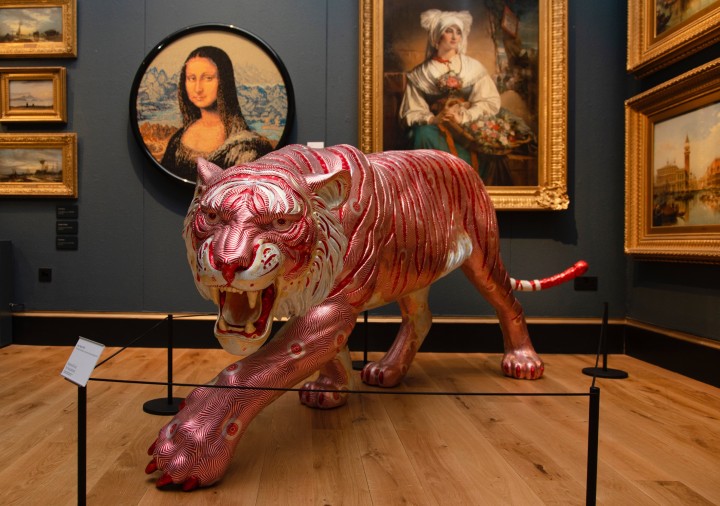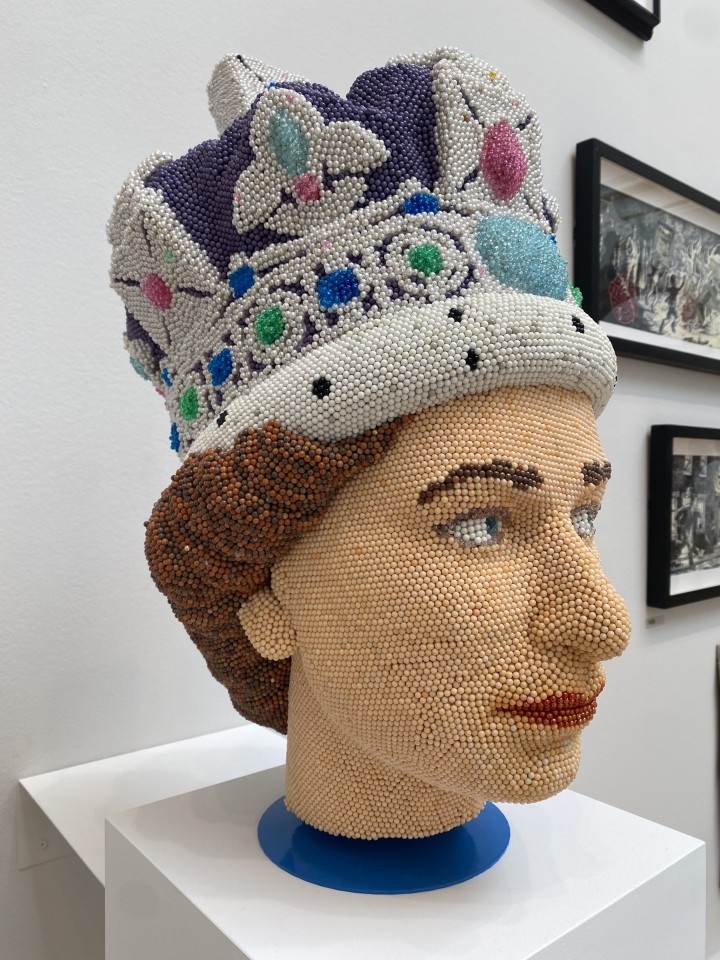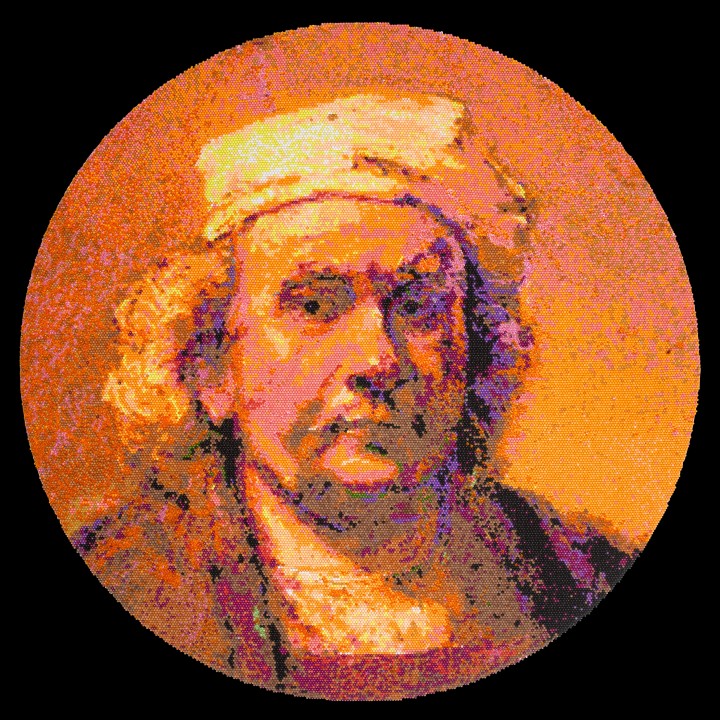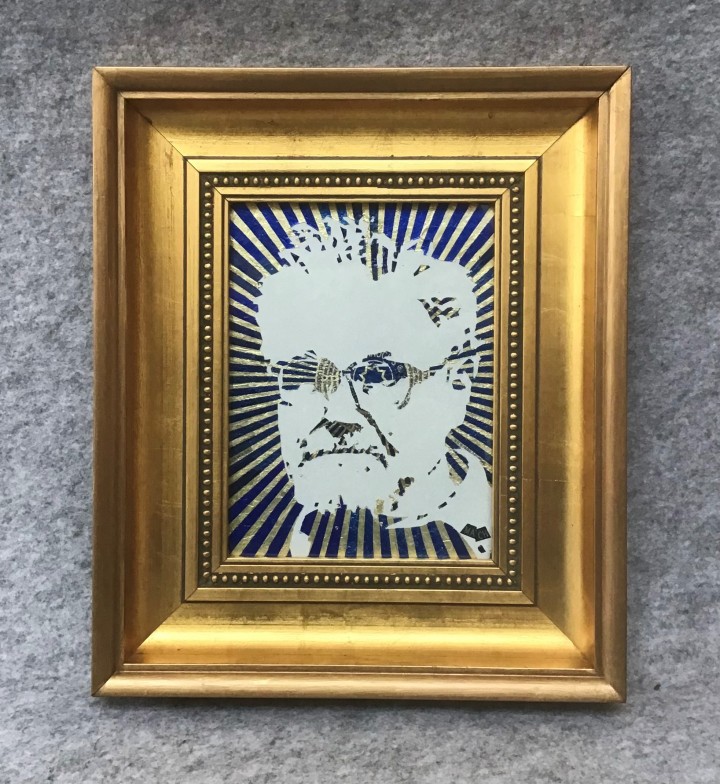Scottish Art News
Latest news
Magazine
News & Press
Publications
Interview: David and Robert Mach
By Susan Mansfield, 01.03.2024

David and Robert Mach and I sit down to talk with mugs of tea and Tunnock’s tea cakes. It couldn’t be anything else - they’ve just introduced me to ‘Easy Tiger’, the first work they made together, a life size beast whose stripes are from Tunnock’s foil wrappers.
We’re at the Stirling Smith Art Gallery and Museum where the brothers are installing MACH2, their first joint exhibition, kicking off a year of celebrations for the gallery’s centenary. In fact they’ve been working together for years - Robert has assisted David on most of his best known pieces - but here they share the billing for the first time.
Around us, pieces of work have been unwrapped: small Tunnock’s tigers and Jeff Koons-esque balloon dogs (Robert), big photo collages and a head of the Queen made with coloured pins (David), a floor-standing vase patterned with foil Matisse dancers (both). In the main picture gallery, pin versions of the Mona Lisa and a Rembrandt self portrait have been hung among the oil paintings.
 "Anarchy in the UK", 2023, image courtesy of the artist and Stirling Smith Art Gallery and Museum
"Anarchy in the UK", 2023, image courtesy of the artist and Stirling Smith Art Gallery and Museum
“How many places would let you do that?” says David. “As if we’d broken into the gallery in the middle of the night and taken one of their pictures off the wall and put up one of our own and not told anybody about it. Hit and run!” And they both laugh, like two mischievous wee boys.
David, older by six years, has recently relocated to Fife after 42 years in London, buying a house just down the road from his brother, a few miles from where they grew up. He has closed his London studio, saying his work is mainly site-specific installations these days, but seems to be as busy as ever in addition to having a seven-month-old baby with his girlfriend, artist Lyndsey Gibb.
The Smith show is his first in Scotland since Precious Light, which filled four floors of the City Art Centre in Edinburgh in 2011. A whirlwind of restless energy, he does most of the talking, though Robert - quieter, calmer - pitches in to fill important gaps. They finish each other’s sentences.
To David’s surprise, Robert didn’t go to art school (“I wondered what the f*** you were doing, you would have raced through it”). After a degree in philosophy, he was a systems analyst, then garden centre manager, then full-time dad, combined with helping David. From the tank made of Yellow Pages to the temple built from tyres and the monumental crucifixes which fronted Precious Light, he was Mach senior’s right-hand man.
“I knew if I left Robert in charge, I wouldn’t come back to a disaster,” David says. “We’ve got such a similar take on a lot of stuff. We ended up getting the same table from Ikea, the same set of chairs!” Robert says: “I’d be at home working on a match head that someone in South America has bought for £10,000, and I’d have a group of children around me throwing beans at it.”
At the same time, Robert started to make his own work. “You were making big collages, they were getting bigger and bigger, so the only way to go was smaller and smaller,” he says. In 2009, he made his first piece with foil, and this quickly became his trademark, particular his work with Tunnock’s wrappers, a distinctively Scottish form of pop art.
 credit juliette lichman.jpg) Image courtesy of Juliette Lichman
Image courtesy of Juliette Lichman
The Stirling show features a range of foil works, from portraits of Alasdair Gray and Bon Scott to foil takes on Picasso, Miro, Matisse. Now, people he’s never met send him wrappers in the post and Tunnock’s supply him by the roll. As we speak, he smooths the wrapper of his teacake into a perfect square. Has he always done this? “It always amazes me when people don’t.”
The idea of hit-and-run foil work intrigues him. “Every now and again I think about doing something more public, like wrapping the big statue of Wellington outside the Gallery of Modern Art in Glasgow. The problem is it just takes so long to do. It’s a hit and run - if you give us two weeks!”
“I couldn’t do it,” says David. “I’d be infuriated by it. I just love the way it’s in your face, not subtle and not cool but really bracing. I’m looking from one thing to the next wishing I was making that. You know an artist’s work is good when you think ‘I wish I’d done that’.”
 David Mach, 'Rembrandt', 2013, image courtesy of the Artist and the Stirling Smith Art Gallery and Museum
David Mach, 'Rembrandt', 2013, image courtesy of the Artist and the Stirling Smith Art Gallery and Museum
Their collaborative work seems to happen companionably, without rivalry or creative disagreement, in fact without much talk at all, drawing on a shared sensibility. David grins: “It’s funny because we were brought up by people who would be completely mystified by all the activities we just talked about. They would be: ‘What the f***? Why are you doing that?”
The Machs grew up in a council house in Methil, “ordinary” on the outside, but inside full of music, books and stories. Their Polish father, Josef, a miner, had spent two years in a Russian labour camp in Siberia. Their Glaswegian mother came from a family so large her parents sold her to a childless couple. “We never got encouraged to do anything, but in a bizarre way they did encourage you to do everything,” David says.
 Robert Mach, 'Alasdair Gray in Blue', image courtesy of the artist and the Stirling Smith Art Museum and Gallery
Robert Mach, 'Alasdair Gray in Blue', image courtesy of the artist and the Stirling Smith Art Museum and Gallery
Methil was a hive of industry: the coal mine, the brickworks, the power station, the docks, an oil rig assembly yard up the road. “It seemed to be the busiest place,” says David. “To me that’s creative and cultural. So I’ve just watched a thing go past the house which is bigger than three double-decker buses and it’s only part of a leg of an oil platform, and I go to art school and someone shows me a wee sculpture and says ‘what do you think of that?’ Well, not very much.” “We definitely lived in a world where people made things,” Robert adds. “The culture was people making big impressive things, it was all noise and busyness.”
While it’s not hard to see where the ambitious scale of David’s work comes from, he works on small-scale projects too: “I quite like that, not being predictable.” The show features an impressive mirrored display cabinet of vase-shaped sculptures made with pins, in colours and patterns inspired by tropical fish. These, David says, are all his own work, made between 2012 and 2014 when he was commuting from London to Fife to visit his wife, Lesley, who spent her last years in Kirkcaldy after suffering complications following surgery to remove a brain tumour. She died in December 2014.
 Robert Mach, 'Picasso Head', image courtesy of the artist and the Stirling Smith Art Museum and Gallery
Robert Mach, 'Picasso Head', image courtesy of the artist and the Stirling Smith Art Museum and Gallery
“I would spend two weeks in Kirkcaldy sitting next to her for most of the day, and I could sit there and pin stuff if she fell asleep. I could make one of those in a week and a half, two weeks. I was making them on the trains, sitting there pinning a vase trying not to look like some sort of weirdo. I bought five million pins from a company in China, and I’ve actually got about four million of them left.”
Looking to the future, he sees more collaborations with Robert: there is word of Tunnock’s tiger editions for the Royal Academy Summer Show, and of a typically ambitious Mach plan being hatched around public art trails in Fife. And more pins. Definitely more pins. “I’m going to get rid of these four million pins for sure!”
MACH2: David and Robert Mach is at the Stirling Smith Art Gallery & Museum until 7th April




